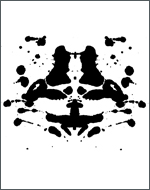

|
Apophenia
Monday, December 15, 2008 | S.M.I.²L.E.
Apophenia is the experience of seeing patterns or connections in random or meaningless data. The term was coined in 1958 by Klaus Conrad, who defined it as the "unmotivated seeing of connections" accompanied by a "specific experience of an abnormal meaningfulness".
While observations of relevant work environments and human behaviors in these environments is a very important first step in coming to understand any new domain, this activity is in and of its self not sufficient to constitute scientific research. It is fraught with problems of subjective bias in the observer. We (like the experts we study) often see what we expect to see, we interpret the world through our own personal lens. Thus we are extraordinarily open to the trap of apophenia.
—Klaus Conrad, A Cognitive Approach to Situation Awareness: Theory and Application
In statistics, apophenia would be classed as a Type I error (false positive, false alarm, caused by an excess in sensitivity). Apophenia is often used as an explanation of paranormal and religious claims, and can also explain a belief in pseudoscience.
Conrad originally described this phenomenon in relation to the distortion of reality present in psychosis, but it has become more widely used to describe this tendency in healthy individuals without necessarily implying the presence of neurological or mental illness.
Dark Side of the Rainbow
An example of apophenia is the apparent synchronicity between the 1939 film Wizard of Oz and the Pink Floyd album Dark Side of the Moon.
You need Flash to navigate this site.
Fans have compiled more than one hundred moments of perceived interplay between the film and album, including further links that occur if the album is repeated through the entire film. This synergy effect has been described as an example of synchronicity, defined by the psychologist Carl Jung as a phenomenon in which coincidental events "seem related but are not explained by conventional mechanisms of causality.", although most accounts assume that the effect was deliberate on Pink Floyd's part. Detractors[6] argue that the phenomenon is the result of the mind's tendency to think it recognizes patterns amid disorder by discarding data that does not fit. Psychologists refer to this tendency as apophenia. Under this theory, a Dark Side of the Rainbow enthusiast will focus on matching moments while ignoring the greater number of instances where the film and the album do not correspond.
Pink Floyd band members have repeatedly insisted that the reputed phenomenon is coincidence. In an interview for the 25th anniversary of the album, guitarist/vocalist David Gilmour denied that the album was intentionally written to be synchronized with Oz, saying "Some guy with too much time on his hands had this idea of combining Wizard of Oz with Dark Side of the Moon."
On an MTV special about Pink Floyd in 2002, the band dismissed any relationship between the album and the movie, saying that there were no means of reproducing the film in the studio at the time they recorded the album.
In a 2003 interview with Rolling Stone, Dark Side of the Moon engineer Alan Parsons said of the supposed effect:
It was an American radio guy who pointed it out to me. It's such a non-starter, a complete load of eyewash. I tried it for the first time about two years ago. One of my fiancee's kids had a copy of the video, and I thought I had see what it was all about. I was very disappointed. The only thing I noticed was that the line "balanced on the biggest wave" came up when Dorothy was kind of tightrope walking along a fence. One of the things any audio professional will tell you is that the scope for the drift between the video and the record is enormous; it could be anything up to twenty seconds by the time the record's finished. And anyway, if you play any record with the sound turned down on the TV, you will find things that work.
Real or imagined, the effect is usually created by pausing a CD of the album at the very beginning, starting the DVD or tape of the film with the TV volume muted, and un-pausing the CD when the black-and-white MGM lion roars for the third time. (Note some versions have a color lion also. The black and white lion is the right one to use for the sync.) A minority of devotees argue that un-pausing the CD on the first roar produces a superior alignment. The effect can be repeated during the film by restarting the CD when the 'Cowardly Lion', during his initial scene, roars for the third time.

|


|

